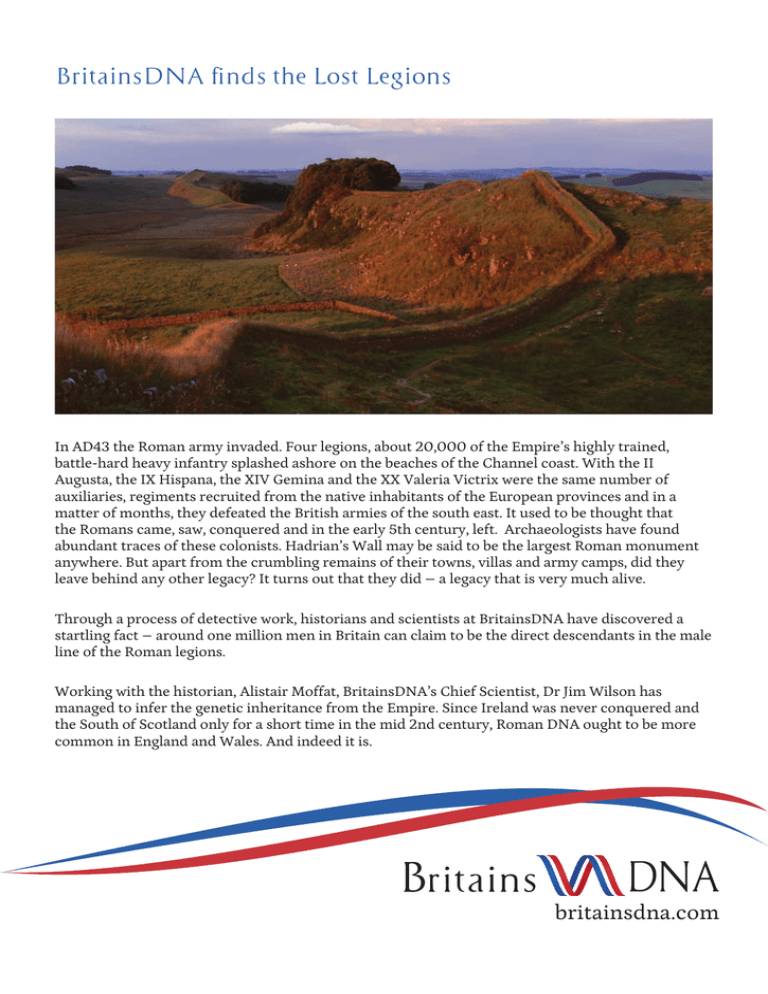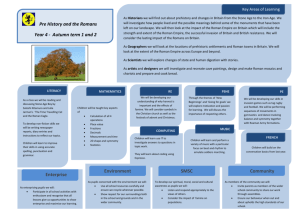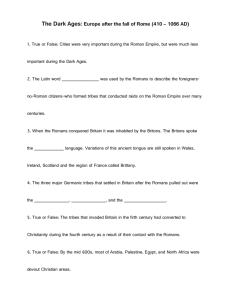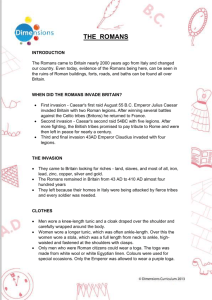BritainsDNA finds the Lost Legions
advertisement

BritainsDNA finds the Lost Legions In AD43 the Roman army invaded. Four legions, about 20,000 of the Empire’s highly trained, battle-hard heavy infantry splashed ashore on the beaches of the Channel coast. With the II Augusta, the IX Hispana, the XIV Gemina and the XX Valeria Victrix were the same number of auxiliaries, regiments recruited from the native inhabitants of the European provinces and in a matter of months, they defeated the British armies of the south east. It used to be thought that the Romans came, saw, conquered and in the early 5th century, left. Archaeologists have found abundant traces of these colonists. Hadrian’s Wall may be said to be the largest Roman monument anywhere. But apart from the crumbling remains of their towns, villas and army camps, did they leave behind any other legacy? It turns out that they did – a legacy that is very much alive. Through a process of detective work, historians and scientists at BritainsDNA have discovered a startling fact – around one million men in Britain can claim to be the direct descendants in the male line of the Roman legions. Working with the historian, Alistair Moffat, BritainsDNA’s Chief Scientist, Dr Jim Wilson has managed to infer the genetic inheritance from the Empire. Since Ireland was never conquered and the South of Scotland only for a short time in the mid 2nd century, Roman DNA ought to be more common in England and Wales. And indeed it is. britainsdna.com A special sort of DNA passed on only by men shows up this extraordinary link with the legions very well. Y chromosome markers found in men in Britain, but at higher frequencies in England and Wales, were compared with markers found in modern Italy. This was done because for much of the period of the Empire only Roman citizens could enlist as legionaries and the overwhelming majority were either Italians or the descendants of Italians who had colonized the early provinces in what are now France and Spain. Five major YDNA markers are likely to represent at least a partial sense of the genetic stamp of the legions. But the first of these almost certainly began to arrive in Britain much earlier, around 2,500BC, and perhaps even before then. Known as Alpine, R1b-S28 is found at a frequency of 13% in Italy, 6.5% in England and Wales, 4.3% in Scotland and 1.8% in Ireland. It may well have been the marker of much earlier immigrants, but its frequency in Italy and England and Wales compared to the notably lower percentages in parts of Britain never or little occupied makes it a probable candidate as a legacy of the legions. At the 2011 census, the combined population of England and Wales was 56 million. If approximately half that number are men, and discounting the 3.75m in England and Wales who are foreign-born, that means a total of 1.6m carry the Alpine marker. Discounting those who arrived before the legions disembarked in 43 or after the remnants of the Roman administration left in 410, that may mean that around half a million men in England and Wales are descended from the men who marched behind the eagle standards. Now, if that calculation feels highly speculative, other factors may show it actually to be conservative. It is important to note that at least four additional YDNA markers may have arrived with the Romans. What have been described as the Balkan group (E-V13), the Ancient Caucasians (G-S314), the Herdsman-Farmers (J-M172 – and a sub-group of this, M67, looks particularly Italian) britainsdna.com and the Anatolian marker (R1b-M269*), when taken together, potentially add another 2.3 million Englishmen and Welshmen who could trace their fatherlines to the veterans of the II Augusta, the IX Hispana, the XIV Gemina, the XX Valeria Victrix and the other Italians who crossed to Britain in their wake. This, in turn, appears to be far too large a number, and so a very big proportion, perhaps two thirds of the carriers of these four markers should be subtracted on the basis that they came to Britain either before or after the time of the province, from 43 to 410. But what even rudimentary calculations show is that many British men, in the direct male line, may indeed be descendants of the Romans, perhaps as many as 1 million, perhaps more. No account has been taken of other, rarer groups likely brought by the Romans. Carriers of E-V22, J-M267, E-M34 and T-M184 add up to approximately 2% of Englishmen. Since the number of Italians or descendants of Italians in the legions did reduce very much over time, we estimate conservatively that 1 million men in Britain descend from Romans in the direct male line. What this fascinating piece of research shows is that the Romans did indeed do something for us, for about a million of us in fact. britainsdna.com Contact Information For more information about this press release contact: Alistair Moffat Managing Director, BritainsDNA 01896 800 720 07788 578 161 Helen Moffat Marketing Manager, BritainsDNA 01896 800 720 07881 249 368 Notes to Editor: Launched in April 2012, BritainsDNA immediately set out to innovate. By combining historical analysis with the genetic information that can be gleaned from testing for ancestral DNA, we aimed to achieve a new understanding of Britain’s history – a people’s history. A commercial company closely involved in scientific research, BritainsDNA offers a unique package of information featuring thorough historical analyses of results currently unmatched by any other European DNA ancestry testing company. britainsdna.com





